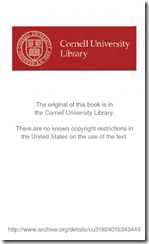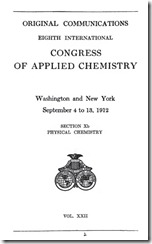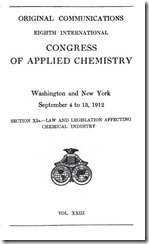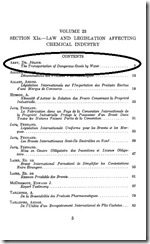In the preamble of IMDG Code we can see that the 1929 International Conference on Safety of Life at Sea (SOLAS) recognized that there is a need for international regulation of the transport of dangerous goods by sea.
1948 SOLAS conference adopted the classification of dangerous goods and certain general provisions. The preamble further says that in the 60s further studies were done and in co-operation with the UN Committee of Experts, the model regulations were established. Through the decades it went through various changes and amendments.
From 1st January 2012 IMDG code 2010 edition ( 35th Amendment) will be mandatory for transport of dangerous goods by Sea under Chapter VII part A of SOLAS, 1974, as amended.
In this article we are not going to dig out the entire history of maritime dangerous goods transport regulations. It will be an enormous task 😉
Let us look at an excerpt of proposal submitted by Dr. Julius Abby of Antwerp, Belgium at the “Eighth International congress of Applied Chemistry, conducted at Washington/New York, between September 4 to 13, 1912″.
THE TRANSPORTATION OF DANGEROUS GOODS BY WATER
Bt Dk. Julius Abby
Antwerp, Belgium
In the two preceding Congresses, at Rome in 1906 and London in 1909, the question of the transportation of dangerous goods by water has already been treated by Dr. C. A. von Martius of Berlin. I therefore deem it unnecessary to particularly insist on the reasons in favor of the solution of a problem equally interesting to chemical factories, navigation companies, imderwriters and, last but not least, the passengers and crews of steamers and sailing ships. It will be sufficient to study the two mentioned reports,^ but what I wish first of all to point out is that, as far as I know. Dr. von Martius’ appeal for an international regulation of the question, and the summoning of a conference to this effect, has not obtained even the commencement of a solution, whilst, on the other hand, the number of accidents increases, and the difficulties between manufacturers and shippers are augmenting. This is forcibly brought to my notice in the course of a regular practice with the shipping companies in Antwerp.
To fully comprehend the question, it will be necessary, first of all, to briefly enumerate the principal authors who have occupied themselves with it, and the publications relating to same. In chronological order:
………..
All these studies are certainly very interesting and useful, but they do not give entire satisfaction to the shippers, for the following reasons:
(1) They are only published in one language.
(2) They are not complete, and, in some cases, lack a convenient index.
(3) They do not indicate in a sufficiently clear and concise manner those properties of goods with which shippers ought to be familiar.
In my book “Dangerous Goods” (quoted under N°7) published in 1910, I have endeavored to comply with the above-mentioned points, and the fact that it is now used regularly by many shipping companies in Europe, may be counted as a proof of its utility to this side of the interested parties. From the other side, i.e., the chemical industry, I have been sharply criticized on this work by certain German parties (Chemische Industrie, 1911, pp. 146- 238 and 605) and this appears to me an additional reason for urging that the representatives of the chemical industry of all coimtries here present should not underestimate the importance of this question.
As a result of the last annual meeting at Stuttgart, in 1911, of the “Union for the protection of the interests of the chemical industry in Germany,” a commission was appointed of three members in order to study the question of the transportation of dangerous objects. This is a beginning, and with confidence we may await the results. But in the great country whose hospitality we are at present enjoying, there exists a perfected institution, too little known in Europe, and to which I wish to draw attention; I mean the “Bureau for the safe transportation of explosives and other dangerous articles” at Washington.
Great benefit would be derived from a study of the organization and the publications of this Bureau.
I have mentioned at the beginning of this report that the importance of the question of the transportation of dangerous merchandise can no longer be ignored. If I cite a few examples hereafter, it is only because nothing else would more forcibly
justify the conclusions and resolutions which I desire to put before this Congress.
1. Bleaching Powder. Cases of decomposition accompanied by elevation of temperature have been observed, and fires on board of ships attributed to them. Bleaching powder, according to information from manufacturers, is capable of decomposition when freshly prepared, but, they say, only for three days after fabrication. Under these circumstances it will easily be imderstood that bleaching powder cannot be classified among the absolutely safe products, and it is only just to demand that the manufacturers should take necessary measures to avoid accidents.
2. Permanganate of Potassium. This compound was considered absolutely dangerless until the occurring of the following case: some of this salt, escaping from the packing, and mixing with dust of a combustible nature, caused the beginning of a fire under the influence of friction. In this respect, permanganate of potassium resembles peroxide of barium. The natural conclusion to be drawn from this fact is that the packing of this product should be very carefully supervised.
3. Arsenic Acid. This is a liquid regularly transported in iron drums to America, and one could hardly have foreseen the accident which happened at New York about a year ago. The explanation was found in the fact that the arsenic acid in question still contained traces of nitric acid. The latter burst the iron drums, and the contents sprayed over the men, causing the death of one of them. It will be necessary in future, therefore, to ensure that the arsenic acid does not contain an excess of nitric acid, and that it should be preserved against heat and the rays of the sun.
4. Metallic Sodium. In contact with water, this product is inflammable, and it is therefore quite evident that it should never be loaded on deck. The ignoring of this fact has, this year, caused the loss of a vessel, and the death of two of the crew.
5. Cyanamide of Calcium. Three years ago I already called attention to the danger of this manure, because, when badly manufactured, it still contains carbide of calcivun, which, by the moisture in the air, gives ofE acetylene. My previsions have recently (in May last) received a sad confirmation in the blowing up of a Norwegian steamer loaded with cyanamide of calcium. Eight men were killed in this catastrophe, which would have been prevented if it had been known that the approach of a naked flame had to be strictly avoided.
It is useless to prolong the list of these examples. They prove sufficiently, I think, that no one, more so than the manufacturer himself, should indicate the necessary precautions to be taken in the transportation of certain goods. If the manufacturers do not themselves consider this question in an efficacious manner, it is probable that the shipping companies will have to take measures, or else the authorities whose duty it is to safeguard the following resolutions:
1. It is desirable that this Congress should appoint an international commission of representatives of the chemical industry, in order to establish, and keep up to date, a list of dangerous goods; to centralize all communications on this subject; to study the special literature; to collect and examine samples; and, perhaps, organize an information service for governments, shipping companies, insurance companies, etc.
2. It is further desirable that this commission should ,invite to join them authorized representatives of shipping companies.
While reading above we will understand what concerns were there 100 years before regarding transport of dangerous goods and after one hundred years how fortunate we are to have an established international rule available to ensure safe transport.
But still the concern is ignorance!!!
This article is influenced by an article on same topic by John de Bruin in Linkedin.com





 WhatsApp your queries
WhatsApp your queries
[…] 早在1929年, 在海上生命安全国际大会(SOLAS)上,人们便意识到对于海洋运输危险品有制定国际公约的需要。如果你想了解更多,请看危险品法规的历史。 […]